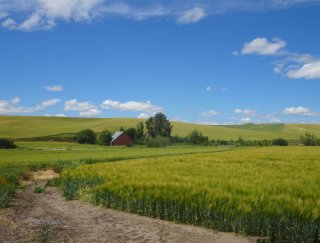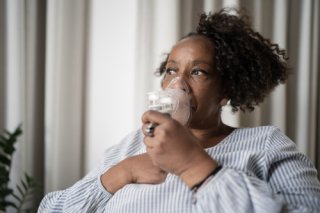Climate Change and the Health of Socially Vulnerable People

Certain groups are more vulnerable than others to the health impacts of climate change due to social and economic factors like income, education, health care access, and housing. Such factors can affect people’s ability to prepare for and cope with climate hazards. Socially vulnerable groups in the United States include communities of color, low-income groups, certain immigrant groups, and those with limited English proficiency.1 These groups may be more at risk because:
- They may live in locations that are prone to climate-related health hazards, such as flooding, extreme heat, and air pollution.2
- They can have greater rates of existing medical conditions, such as physical disabilities, poor mental health, kidney disease, diabetes, asthma, or heart disease, which can be worsened by climate change impacts.3
- They may live in urban and rural areas with poorly maintained or aging infrastructure that may not be able to handle climate-related events. Such infrastructure can include buildings, utilities, and transportation and health care systems. Individuals in these communities may also struggle to access resources and care during and after extreme weather events.4
- They may have limited financial resources or cultural, language, or citizenship barriers that restrict their access to health care, social services, and safe, nutritious food.
Key Threats to the Health of Socially Vulnerable People
A number of climate-related hazards threaten the health of socially vulnerable people in the United States. Below are some examples of the potential health impacts of these hazards.
- Heat Illnesses
- Respiratory Illnesses
- Water-Related Illnesses
- Food System Impacts
- Insect-Related Diseases
- Mental Health Effects
Heat Illnesses

Heat illnesses can occur when a person is exposed to high temperatures and their body cannot cool down. Increases in average and extreme temperatures and heat waves are expected to lead to more heat illnesses and deaths among vulnerable groups, including certain socially vulnerable groups.8 These include low-income households, communities of color, those experiencing homelessness, and immigrant populations.9
Many of these groups live in urban areas that are prone to extreme heat (urban heat islands).10 Some may also live in housing that does not have adequate insulation or cooling. Others may not be able to afford air conditioning.11
Respiratory Illnesses
Climate change may lead to more outdoor air pollutants, including particulate matter and ground-level ozone. These pollutants can affect some socially vulnerable people, such as those living in cities with high air pollution levels or those with limited access to measures to reduce their exposure.13, 14

Socially vulnerable groups are often more sensitive to air pollutants because they have more exposures and higher rates of underlying medical conditions.15 As a result, they are at a higher risk for developing severe illnesses, needing to go to a hospital, or prematurely dying.16
In addition, climate change can increase allergens like pollen that can trigger or worsen asthma. Data show the ragweed pollen season is already becoming longer in some U.S. locations.17 Asthma is more common among some communities of color and low-income households than the general population.18
Dust from agriculture and droughts can also affect individuals in rural communities. Wildfire smoke can be a hazard in both urban and rural areas. Low-income individuals who live in buildings that are older or in poor condition can be exposed to damp indoor environments. Dampness can increase mold, bacteria, and other indoor air pollutants, especially after floods and extreme weather events.19 Lower-income households may lack the resources to buy air cleaners that can help reduce some of these pollutants.
Water-Related Illnesses
Climate change will impact water resources in many ways. For example, changes in water and air temperatures, heavier and longer rains, flooding, and rising sea levels can introduce disease-carrying organisms into drinking water supplies and recreational waters.21 In both urban and rural low-income areas, water resources—such as sewer, stormwater, and drinking water systems—may be old or not able to withstand climate impacts such as storm surge and heavy rains. As a result, these areas can be more vulnerable to water quality issues.22
Low-income households near floodplains can also be more exposed to water pollutants, particularly due to sea level rise, heavy rainfall, or extreme weather events.23 They may also have higher flood insurance costs and more difficulty getting insurance.24
Certain people may be part of other groups vulnerable to climate change. This can increase their health risks. For example, an older adult with a limited income and mobility issues may have trouble getting to a safe place during a heat wave. Some immigrants, communities of color, and low-income individuals may also have higher rates of chronic medical conditions that can be worsened by climate change impacts.7
Food System Impacts
Climate-related hazards—especially floods, wildfires, and droughts—could affect food production and distribution. These issues, in turn, could impact food quality and availability.25
Some communities of color and low-income populations already struggle to get nutritious food due to limited finances and access to grocery stores with good-quality, affordable options.26 Climate-related food shortages and supply chain issues could make it even more difficult for people to get healthy food.27
Insect-Related Diseases
Warmer temperatures brought on by a changing climate can increase mosquito development and biting rates. Increased rainfall or standing water from sea level rise can also create more breeding sites for mosquitoes.28
Higher incidences of West Nile virus, which is transmitted by mosquitoes, have been linked to poverty in the Southeast and urban locations in the Northeast.29 While most people infected with West Nile virus do not feel ill, some develop more severe sicknesses.30

Mental Health Effects
As the climate changes, conditions are becoming more favorable to more extreme weather.31 Certain communities of color, lower-income individuals, rural populations, and immigrant groups are more likely to experience mental health effects from such events.
These groups may already face barriers to getting mental health care, counseling in native languages, and medication. Extreme weather can disrupt access to mental health care even further, which can cause or worsen mental health effects.32
Individuals, businesses, governments, and society as a whole can take action at different scales to ensure that all populations are equally protected from climate-related health hazards. Community members can consider the following actions:
- Get involved locally. Get to know local, state, and regional leaders. Consider joining an advisory board or neighborhood council.
- Look for funding opportunities. Help your community apply for a grant to support a local environmental or public health project. The Office of Minority Health provides funding to help organizations address health disparities.
- Help your neighbors during an emergency. If possible, help each other access transportation, health care, shelter, and information. If you speak more than one language, consider translating news alerts to help people prepare for an extreme weather event.
- Improve your home. Seal air leaks around your home to help control temperature and lower energy costs. Contact your local utility or housing authority about programs and resources to increase the safety and efficiency of your home.
- Stay informed about air quality. Check out AirNow for air quality data where you live. This information can help you make informed choices about outdoor activities and possible health impacts.
- Plant trees and community gardens. Green spaces can help cool urban heat islands.
Related Resources
EPA resources:
Other resources:
Endnotes
1 Gamble, J.L., et al. (2016). Ch. 9: Populations of concern. In: The impacts of climate change on human health in the United States: A scientific assessment. U.S. Global Change Research Program, Washington, DC, p. 252.
2 Gamble, J.L., et al. (2016). Ch. 9: Populations of concern. In: The impacts of climate change on human health in the United States: A scientific assessment. U.S. Global Change Research Program, Washington, DC, p. 252.
3 Gamble, J.L., et al. (2016). Ch. 9: Populations of concern. In: The impacts of climate change on human health in the United States: A scientific assessment. U.S. Global Change Research Program, Washington, DC, p. 252.
4 Gamble, J.L., et al. (2016). Ch. 9: Populations of concern. In: The impacts of climate change on human health in the United States: A scientific assessment. U.S. Global Change Research Program, Washington, DC, pp. 252–253.
5 Gamble, J.L., et al. (2016). Ch. 9: Populations of concern. In: The impacts of climate change on human health in the United States: A scientific assessment. U.S. Global Change Research Program, Washington, DC, pp. 252–253.
6 Centers for Disease Control and Prevention (CDC). (2024). About Rural Health. Retrieved 7/16/2024.
7 Gamble, J.L., et al. (2016). Ch. 9: Populations of concern. In: The impacts of climate change on human health in the United States: A scientific assessment. U.S. Global Change Research Program, Washington, DC, p. 252.
8 Crimmins, A., et al. (2016). Executive summary (pdf) (5 MB). In: The impacts of climate change on human health in the United States: A scientific assessment. U.S. Global Change Research Program, Washington, DC, p. 6.
9 Gamble, J.L., et al. (2016). Ch. 9: Populations of concern. In: The impacts of climate change on human health in the United States: A scientific assessment. U.S. Global Change Research Program, Washington, DC, p. 252.
10 Gamble, J.L., et al. (2016). Ch. 9: Populations of concern. In: The impacts of climate change on human health in the United States: A scientific assessment. U.S. Global Change Research Program, Washington, DC, p. 252.
11 Gamble, J.L., et al. (2016). Ch. 9: Populations of concern. In: The impacts of climate change on human health in the United States: A scientific assessment. U.S. Global Change Research Program, Washington, DC, p. 252.
12 U.S. Bureau of Labor Statistics. (2023). Labor force characteristics by race and ethnicity, 2022. Retrieved 11/22/2024.
13 Gamble, J.L., et al. (2016). Ch. 9: Populations of concern. In: The impacts of climate change on human health in the United States: A scientific assessment. U.S. Global Change Research Program, Washington, DC, p. 253.
14 U.S. Environmental Protection Agency (EPA). (2021). Wildfire smoke: A guide for public health officials. EPA-452/R-21-901.
15 Gamble, J.L., et al. (2016). Ch. 9: Populations of concern. In: The impacts of climate change on human health in the United States: A scientific assessment. U.S. Global Change Research Program, Washington, DC, p. 253.
16 Gamble, J.L., et al. (2016). Ch. 9: Populations of concern. In: The impacts of climate change on human health in the United States: A scientific assessment. U.S. Global Change Research Program, Washington, DC, p. 253.
17 EPA. Climate change indicators: Ragweed pollen season. Retrieved 3/11/2022.
18 CDC. (2021). Most recent national asthma data. Retrieved 11/22/2024.
19 EPA. (2021). Indoor air quality and climate change. Retrieved 3/11/2022.
20 CDC. (2021). Most recent national asthma data. Retrieved 11/22/2024.
21 Trtanj, J., et al. (2016). Ch. 6: Climate impacts on water-related illness. In: The impacts of climate change on human health in the United States: A scientific assessment. U.S. Global Change Research Program, Washington, DC, p. 159.
22 Gamble, J.L., et al. (2016). Ch. 9: Populations of concern. In: The impacts of climate change on human health in the United States: A scientific assessment. U.S. Global Change Research Program, Washington, DC, p. 253.
23 Bell, J.E., et al. (2016). Ch. 4: Impacts of extreme events on human health. In: The impacts of climate change on human health in the United States: A scientific assessment. U.S. Global Change Research Program, Washington, DC, p. 106.
24 Federal Emergency Management Agency. (2022). Risk rating 2.0: Equity in action. Retrieved 3/11/2022.
25 Ziska, L., et al. (2016). Ch. 7: Food safety, nutrition, and distribution. The impacts of climate change on human health in the United States: A scientific assessment. U.S. Global Change Research Program, Washington, DC, p. 191.
26 Gamble, J.L., et al. (2016). Ch. 9: Populations of concern. In: The impacts of climate change on human health in the United States: A scientific assessment. U.S. Global Change Research Program, Washington, DC, p. 253.
27 Bolster, C.H. et al. (2023). Ch. 11: Agriculture, Food Systems, and Rural Communities. Fifth National Climate Assessment. U.S. Global Change Research Program, Washington, DC, p. 11-17.
28 Beard, C.B., et al. (2016). Ch. 5: Vector-borne diseases. In: The impacts of climate change on human health in the United States: A scientific assessment. U.S. Global Change Research Program, Washington, DC, pp. 141–142.
29 Gamble, J.L., et al. (2016). Ch. 9: Populations of concern. In: The impacts of climate change on human health in the United States: A scientific assessment. U.S. Global Change Research Program, Washington, DC, p. 253.
30 CDC. (2021). West Nile virus. Retrieved 3/11/2022.
31 Intergovernmental Panel on Climate Change (IPCC). (2021). Summary for policymakers (pdf) (123 MB). In: Climate Change 2021: The physical science basis. Contribution of Working Group I to the sixth assessment report of the Intergovernmental Panel on Climate Change. Cambridge University Press, in press, pp. 5–14.
32 Gamble, J.L., et al. (2016). Ch. 9: Populations of concern. In: The impacts of climate change on human health in the United States: A scientific assessment. U.S. Global Change Research Program, Washington, DC, p. 253.
33 Dodgen, D., et al. (2016). Ch. 8: Mental health and well-being. In: The impacts of climate change on human health in the United States: A scientific assessment. U.S. Global Change Research Program, Washington, DC, p. 220.
